Tomatopalooza
- By Pia Hinckle
- Reading Time: 3 mins.
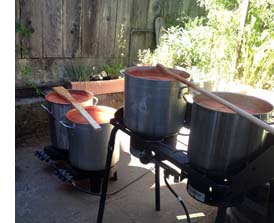 A Canning Primer
A Canning Primer
By Pia Hinckle
Harvest time always brings an embarrassment of riches to your table. What to do with 25 pounds of zucchini? Tomatoes finally came in last week? Can’t eat another pear tart but ready to try making preserves? Using this basic primer on canning — or jarring, really — anyone can do it. Jar fresh tomatoes, fruits, and vegetables, or sauces and soups.
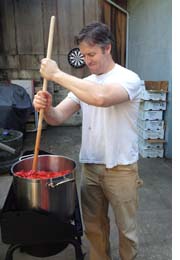
My family and I just made our annual tomato sauce using my Italian great-grandmother Pia’s recipe. In 2012 we used a whopping 300 pounds of organic San Marzanos and dry-farmed organic Early Girl tomatoes on a 2-1 ratio. Added chopped carrots, celery, onion, garlic, and herbs; cooked down for many hours in many giant pots; then passed through a mini commercial tomato press to remove the seeds and skins. We got about 15 gallons of sauce this year, which is now residing in tidy quart jars in the basement with “2012” written on them all.
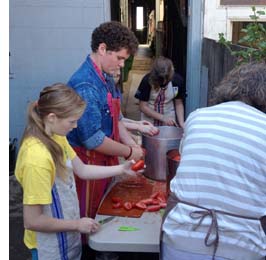
Michael Pollan, the author of “In Defense of Food: An Eater’s Manifesto,” has written that obesity rates correlate with how much time people spend in the kitchen. Believe it or not, the more you cook, the less likely you are to be obese. (FYI, putting frozen food in the microwave doesn’t count as cooking!) There are many websites that can educate you on the dos and don’ts of canning, I like pickyourown.org or healthycanning.com. Most of these sites also sell canning supplies if you need them. Many, such as jars and lids, can be found at your local supermarket as well.
Want farm-fresh fruit?
We've got you covered.
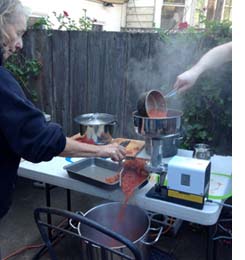 So enjoy the harvest and preserve some of it for later.
So enjoy the harvest and preserve some of it for later.
Equipment
- Mason jars with lids (wide-mouth jars are easiest to fill). Always use new lids.
- Canner, or large pot or metal roasting pan, to boil jars
- Jar tongs and potholders
- Wide-mouth jarring funnel
- Ladle, clean dishtowels, and an indelible marker
Preparation
- Sterilize your equipment: start by washing all your jars and lids in the dishwasher.
- Prepare your food to be preserved. Raw fruits and vegetables may require specific treatments before they can be preserved. Consult a cookbook or pickyourown.org or similar website for preparation instructions. Most raw fruits and veggies go into clean jars with liquid and are then capped with an already boiled (sterilized) lid, and then the jar is placed in boiling water to seal it.
- If you make your favorite tomato sauce recipe, keep it at a gentle simmer until you are ready to ladle it into your boiling hot jars.
- Boil jars and lids. Get your pot going at a good gentle boil then put jars and lids in. They must be submerged. Boiling kills bacteria and ensures a good seal.
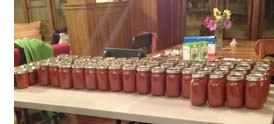 Remove one jar at a time and ladle hot tomato sauce into a jar. Leave a little space at the top. Before getting a lid, make sure the lip of the jar is clean of any sauce. Put on the lid; tighten the ring and set aside. Process in a water bath canner according to directions. Repeat until done.
Remove one jar at a time and ladle hot tomato sauce into a jar. Leave a little space at the top. Before getting a lid, make sure the lip of the jar is clean of any sauce. Put on the lid; tighten the ring and set aside. Process in a water bath canner according to directions. Repeat until done.- As jars cool you should hear a little “ting” as each lid seals. Check within 24 hours by pressing on top of the lid. There should be no give and no sound. Label and store in a cool dry place.
Want farm-fresh fruit?
We've got you covered.Recent Articles
Are Peaches a Citrus? A Farmer Weighs In
Fruit Hybrids, Explained: A Love Story from the Orchard
Subscribe to our Newsletter
"*" indicates required fields





